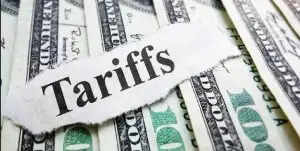How US Tariffs Could Impact Asia-Pacific Economies: A Closer Look
Potential Economic Consequences of US Tariffs

New Delhi: According to S&P Global Ratings, significant economies in the Asia-Pacific region, including India, China, and Japan, may experience a decline in growth by 0.2 to 0.4 percentage points over the next two years if the US proceeds with the reciprocal tariffs announced on April 2.
The agency highlighted that the introduction and threat of these tariffs could dampen global trade and reduce economic confidence. The heavy reliance of these economies on exports to China and the US could severely impact manufacturers and smaller nations.
Eunice Tan, the Asia-Pacific Head of Research at S&P Global Ratings, warned that if the tariffs set for April 2, 2025, are enacted for countries outside of China, the geopolitical and economic repercussions would be significant.
Previously, S&P had forecasted growth rates of 6.5% and 6.8% for India in 2025 and 2026, respectively. However, with the implementation of the tariffs proposed by President Trump, these projections could drop to 6.3% and 6.5%.
Following the April 2 announcement, which caused a global market shock, Trump delayed the implementation of these tariffs by three months, excluding China, which faces a hefty 125% tariff.
Despite this, the 10% additional duty on exports to the US, announced on April 2, remains in effect.
S&P noted that if the tariffs are fully enforced, major economies like China, Japan, and India could see their growth rates decline by 0.2 to 0.4 percentage points over the next two years, with Vietnam, Thailand, and Taiwan facing the most significant impacts.
The agency also indicated that credit conditions in the Asia-Pacific region are likely to worsen as the trade conflict between the US and China escalates, negatively affecting growth and confidence.
Business sentiment is expected to decline further due to stalled investments and deteriorating household confidence, leading to increased volatility in equity and debt markets.
The ongoing trade conflict represents a notable escalation in US-China relations.
Since January 20, the US has imposed an additional 145% tariff on Chinese imports, a significant increase from the previous effective rate of around 15% before Trump's return to office.
Such high tariffs could severely undermine the competitiveness of Chinese exports in the US, posing a substantial challenge to China's economy.
In retaliation to the US tariff increases, China has raised its tariffs on US imports to 125% and continues to enforce export restrictions on rare earth minerals. However, Chinese officials have indicated they will not match any further tariff hikes from the US, as American goods have become economically unfeasible for Chinese buyers at these rates.
S&P cautioned that a further decline in US-China relations could exacerbate confidence issues and disrupt supply chains and global trade, potentially leading to a more pronounced global economic slowdown.
